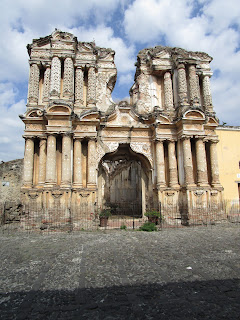 |
| The Arch and the Volcano: the signature view of Antigua |
The City of Antigua, Guatemala, is quite compact. Most of the sights -- and by "sights" I mean "church ruins" -- are in a small area that measures, roughly six blocks by six blocks. There are a few ruins that stray outside that square. And the Cerro de la Cruz (big cross on a hillside) overlooking the city is well outside the square (and unvisited for today). But the main sights are in a confined space.
And this being Guatemala, what other way is there to start the day than with a big ol' cup of Guatemalan bean coffee?
Fortified with the requisite caffeine, it's time to take in the ruins.
The first set of ruinizations would be the remnants of Iglesia San Agustin.
Some of the ruins are open for exploration. Some are not. Iglesia San Agustin is a "not."
Off to trod more of the cobblestone streets of Antigua, with an emphasis on the "cobble" part.
Tomorrow I wear hiking boots, which will make walking on the uneven stones much easier on the feet. And, after only a few blocks, I came upon the most famous, most photographed tourist site in all of Guatemala: the Arco de Santa Catalina.
It is an arch over a street that in the old days of the city functioned as a way for cloistered nuns to get from one building on one side of the street to the other without being exposed to humanity, since their vows allowed no interaction with the rest of the human race.
There are days that I have great envy for such a lifestyle.
Once you cross under the Arch ("arco" is the Spanish word for "arch," not "gas station"), you quickly arrive at the grounds of the Iglesia de la Merced.
It appears to be an actual functioning non-ruined church.
On the other hand, you don't have to walk far to come upon another church ruin.
Antiguo Colegio de la Compañía de Jesús. Only this may not be complete ruins (sort of like my hotel, which is a hybrid of church ruins and useful structure).
Would there be that many motorbikes if these were ruins?
Lots of motorbikes at the Helados Marco Polo ice cream store, too.
Then it is off to the Plaza Mayor,
The highlight of Antigua's Parque Central is this fountain. It includes a woman who has streams of water flowing out from her breast nipples.
That was the profile view. Here she is in landscape.
That is definitely something you do not see everyday.
And here is another hybrid of ruins and function, This is the Cathedral of Antigua Guatemala, the Catedral San José.
It is a functioning cathedral, on the modern side.
Nicely ornate but nothing like you know these ruins were in their day.
But attached to the functional cathedral is the property for the glorious ruins of the Catedral San José.
Which I did. The above damage, with the crumpled column, is not from the massive 1773 earthquake that destroyed Antigua. That damage is more modern. It's from the massive 1976 earthquake that struck Guatemala City.
Antigua and Guatemala City both sit at a point where three tectonic plates collide. California thinks life is difficult on the edges of two tectonic plates. This is where the North American, the Caribbean, and the Cocos Plate (a small plate off the Pacific coast of Central America) collide (often) violently.
So why build cities here and risk such massive destruction? The volcanoes of Guatemala mean that there is extremely rich soil for agriculture, making it worth putting up with the shaking and quaking.
Even if it leaves your beautiful cathedrals in ruins.
The building must have been absolutely spectacular in its day.
One last set of ruins for the day. These are Las ruinas iglesia de la Concepción, the ruins of the Church of the Concepcion.
Lots of work currently being done to get these ruins in good enough shape to show off.
At this point, the sky was looking like some rain. Time for an afternoon break.






























No comments:
Post a Comment